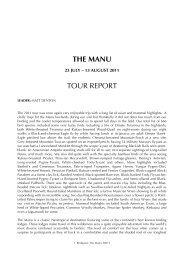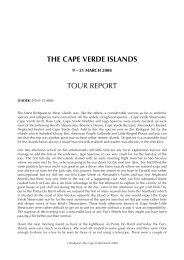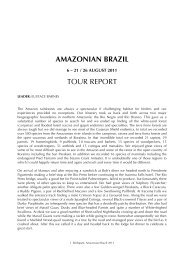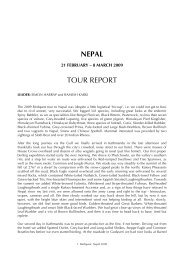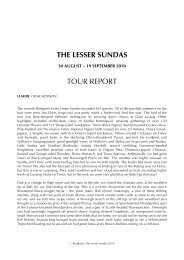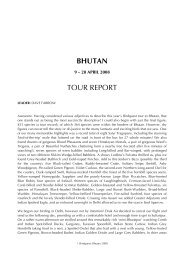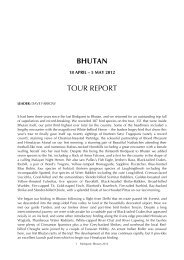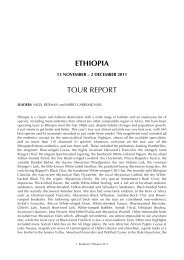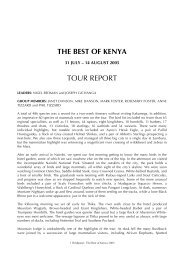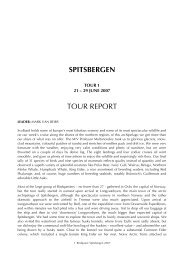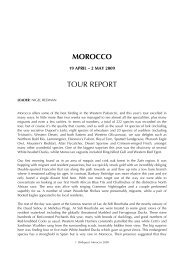MONGOLIA REP 12 - Birdquest
MONGOLIA REP 12 - Birdquest
MONGOLIA REP 12 - Birdquest
You also want an ePaper? Increase the reach of your titles
YUMPU automatically turns print PDFs into web optimized ePapers that Google loves.
Pallas’s Sandgrouse Syrrhaptes paradoxus<br />
This species has a wide breeding range and occurs from the Caspian Sea east to north-eastern China, but it is mainly<br />
known for its irruptive behaviour. Several major irruptions have taken place in western Europe, notably in 1863, 1888 and<br />
1908, when thousands of birds were observed and whereby some birds settled and bred in countries as far apart as<br />
Great-Britain, Sweden and Poland. The epithet paradoxus (= unexpected, strange) obviously relates to this unique<br />
behaviour.<br />
Hill Pigeon (Blue Hill Pigeon) Columba rupestris<br />
This species probably suffers from rivalry with the ever increasing Rock Dove, although studies in the Ulan Ude area<br />
(just across the border in Russia) have shown that hybridization remains limited.<br />
Eurasian Three-toed Woodpecker Picoides tridactylus<br />
The Nearctic form is now split off as a separate species: American Three-toed Woodpecker P. dorsalis.<br />
Pale Martin Riparia diluta<br />
A Saxaul tree (Mark Van Beirs) and the Gobi-Altai mountains (Maire Morton)<br />
This form has now been split off as a separate species (from Sand Martin Riparia riparia) and usually occupies drier<br />
habitat and lives in smaller colonies. They overlap in Kazakhstan and probably in western Mongolia.<br />
Blyth’s Pipit Anthus godlewskii<br />
It is not always easy to separate from Richard’s Pipit, although the display flight and song are quite different. Edward<br />
Blyth was an 19 th century English zoologist who contributed hugely to early Indian ornithology.<br />
Kozlov’s Accentor (Mongolian Accentor) Prunella koslowi<br />
This is a true Mongolian breeding endemic, although there are several winter observations in China. The bird is named<br />
after General Pyotr Kuzmich Kozlov (1863 -1935), a Russian explorer of central Asia and Mongolia.<br />
Eversmann’s Redstart (Rufous-backed Redstart) Phoenicurus erythronota<br />
Eduard Friedrich Eversmann (1794-1860) was a German naturalist, collector and author who travelled in Kirghizia and<br />
Siberia.<br />
Black Redstart Phoenicurus ochruros<br />
We saw the subspecies phoenicuroides, one of the red-bellied races.<br />
Daurian Redstart Phoenicurus auroreus<br />
The bird is named after Dauria or Dahuria, in ancient times the name for the area encompassing parts of eastern<br />
Mongolia and the Chinese province of Heilongjiang.<br />
21 BirdQuest Tour Report: Mongolia 20<strong>12</strong> www.birdquest-tours.com




